Mumbai blasts: 1993
(→Yakub Memon) |
|||
| Line 1: | Line 1: | ||
| + | [[File: A timeline, Yakub Memon, 1993-April, 2015.jpg|A timeline, Yakub Memon: 1993-April, 2015; Graphic courtesy: [http://epaperbeta.timesofindia.com/Gallery.aspx?id=30_07_2015_015_005_003&type=P&artUrl=BLACK-FRIDAY-30072015015005&eid=31808 ''The Times of India''], July 30, 2015|frame|500px]] | ||
| + | [[File: Yakub Memon's response when he was sentenced to death by the TADA court, 2007.jpg|Yakub Memon's response when he was sentenced to death by the TADA court, 2007; Graphic courtesy: [http://epaperbeta.timesofindia.com/Gallery.aspx?id=30_07_2015_015_005_003&type=P&artUrl=BLACK-FRIDAY-30072015015005&eid=31808 ''The Times of India''], July 30, 2015|frame|500px]] | ||
| + | [[File: A timeline, Yakub Memon, April-July 2015.jpg|Graphic courtesy: [http://epaperbeta.timesofindia.com/Gallery.aspx?id=30_07_2015_015_005_003&type=P&artUrl=BLACK-FRIDAY-30072015015005&eid=31808 ''The Times of India''], July 30, 2015|frame|500px]] | ||
| + | |||
{| Class="wikitable" | {| Class="wikitable" | ||
|- | |- | ||
Revision as of 15:11, 30 July 2015
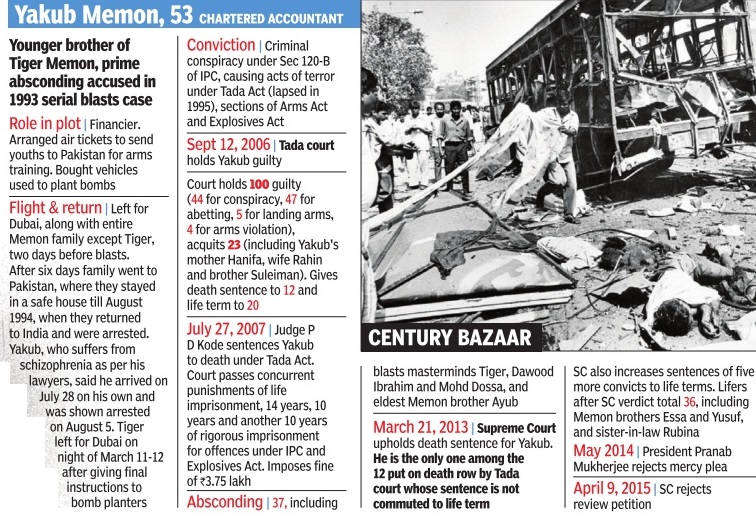
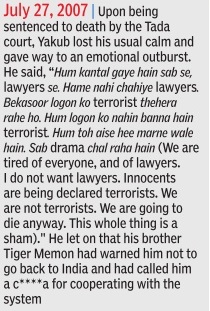
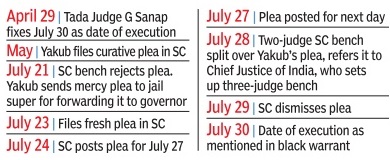
This is a collection of articles archived for the excellence of their content. |
Contents |
Yakub Memon
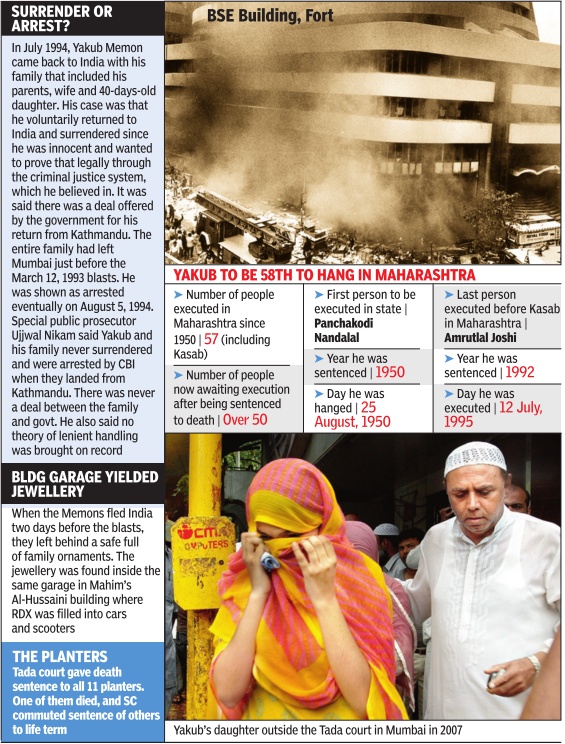
Early life
The Times of India, Jul 23 2015
Mateen Hafeez
Tiger plotted blasts to avenge loss of property
Tiger Memon, who shook Mumbai by conspiring and executing 12 deadly bomb blasts in the city on March 12, 1993, had been a man of revenge since his childhood. The blasts, which the CBI claimed in its chargesheet were to avenge demolition of Babri Masjid, also had an element of Tiger's revenge for the loss of his properties; these were set on fire during the communal riots of 1992-93. Mushtaq Abdul Razzak Nadim Memon, known as Tiger Memon, was born to middle-class parents in south Mumbai's Mohammed Ali Road on November 24, 1960. His father, Razzak, was an avid sportsman who played cricket in the Mumbai League. Razzak was originally known as Tiger after the famed Indian skipper. Later, Memon inherited his father's moniker, with an added `Junior', due to his habit of growling while talking and arguing. “He was vengeful since childhood. Once while playing cricket during his school days. Tiger got injured on the wicket. He was bleeding profusely , but instead of seeking treatment, he insisted on continuing to play and hit the ball. At the end of the match, Tiger had scored a century,“ said S Hussain Zaidi, author of Black Friday ,a book on the blasts.
Yakub may not live to receive degree
Death row prisoner Yakub Memon may not live to receive his MA political science degree from the Indira Gandhi National Open University (IGNOU). The convocation ceremony for it is slated for August 8 while he is likely to be executed on July 30 for his role in the 1993 Mumbai blasts.This is the second degree he pursued as an inmate at the Nagpur Central Jail. The chartered accountant had earlier completed MA in English Literature in 2012 scoring 58% marks. He enrolled for MA Political Science the same year and cleared it in December last year scoring 56% marks.“The degree certificate will be sent from the New Delhi office just before the convocation ceremony,“ said IGNOU regional director P Sivaswaroop.
The only convict on death row
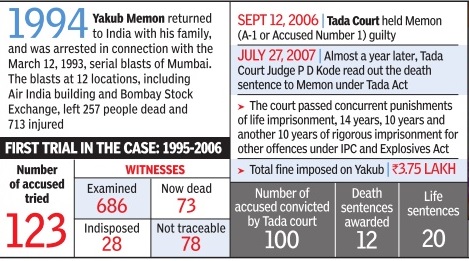
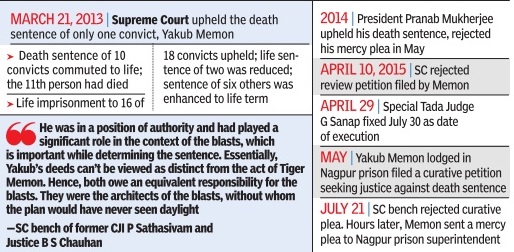
The Times of India, Jul 22 2015
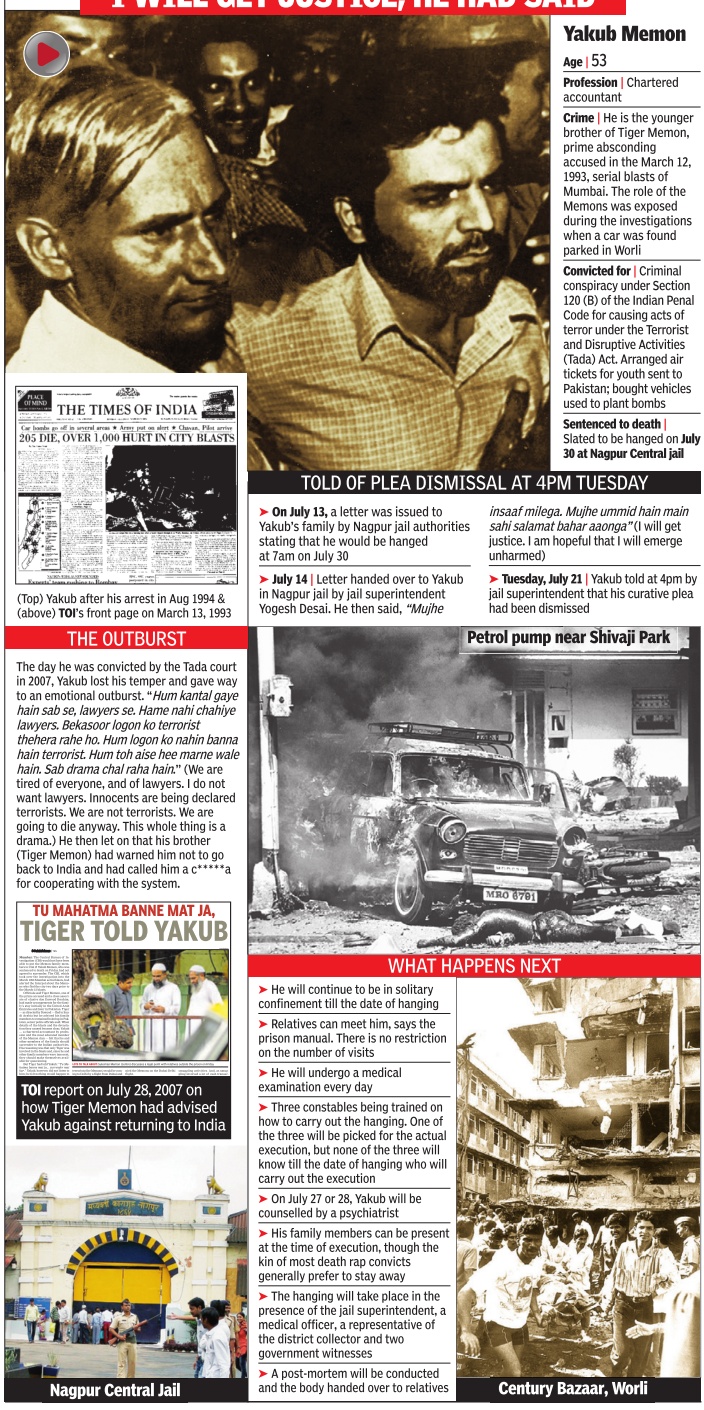
Dhananjay Mahapatra
He wasn't among those who carried arms, but he stood behind them: SC
Tiger Memon's conspiracy , with the help of Dawood Ibrahim, to avenge Babri Masjid demolition at Ayodhya through serial bomb blasts in Mumbai, will now cost him the life of his cub brother Yakub. Mustaq aka Tiger Memon, the alleged mastermind of the 1993 serial blasts, stayed in the trial court records along with Dawood as AA or `absconding accused'. Yakub, who handled details to give concrete shape to the conspiracy and tie the loose ends, was named Accused Number 1 in trial records.
Trial Judge P D Kode had examined in detail the evidence for 13 years before awarding a death sentence to Yakub Memon (A-1) and ten others.
Their sentences were subject to confirmation by Supreme Court. A bench of Justices P Sathasivam and B S Chauhan examined the evidence afresh, given the case's sensitive nature and the large number of death penalties awarded.
The final judgment came on March 21, 2013, almost a year later. Only Yakub's death penalty was confirmed.
Of the 792-page judgment, nearly 300 pages were devoted to examining evidence against Yakub (A-1). Writing the judgment for the bench, Justice Sathsaivam said: “From the total appreciation of the evidence as produced by the prosecution in support of the case against A-1, an offence of conspiracy is clearly made out. The evidence in respect of A-1 is in the nature of confessions made by the co-accused persons, the testimonies of the prosecution witnesses and documentary evidence on record and recoveries.“ The SC said: “The prosecution has also proved recoveries of incriminating articles like hand grenades etc, and also for the purchase of air tickets, getting passports and visas for the persons who went to Pakistan via Dubai for training in handling of arms and ammunitions.“
The court noted Yakub's involvement in handling finances for the blasts. “ Apart from this, there are ample evidence to show that he was in-charge of all money transactions and monitoring the activities of all the persons concerned in the movement.
“The prosecution has also established that A-1 owned a blue Maruti car which was used for carrying explosives and detonators one day before the blasts took place on March 12, 1993. A-1 left for Dubai on March 11, 1993 with the Indian passport and thereafter he entered Pakistan with Pakistani passport.
“Though he was not one among the persons who carried arms and ammunitions used for the blast but it was he who stood behind them from starting till the end, viz conspiracy , planning and making all the arrangements for sending certain persons to Pakistan for training in handling of arms and ammunitions.
“A perusal of the above confessions by the co-conspirators would show that the appellant (A-1) was playing a key role in furtherance of the above said conspiracy . The above evidence along with further material relied on by the prosecution show that A-1 also played an active role in generation and management of funds for achieving the object behind the conspiracy and in all subsequent events,“ the apex court had said on March 21, 2013.
Yakub's counsel Jaspal Singh had argued that the approvers' confession nor that of any other co-accused or any independent witness show that Yakub knew or participated in any conspiracy meeting.
The SC said, “The fact that he was constantly present at Al Hussain building, where the major part of the plans have been made and executed, is established. And his active involvement has also emerged from the evidence on record as to how he was dealing with the so-called men of Tiger...The accused need not be present at each and every meeting for being held to be a part of the conspiracy . (With inputs by Swati Deshpande)
Is the death penalty justified on Indian part?
The Times of India, Jul 25 2015
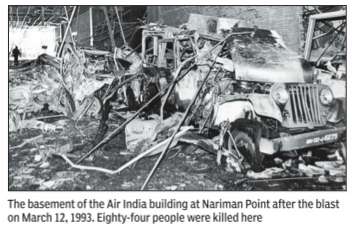
`We promised Yakub he won't hang'
`He wouldn't have surrendered, handed over evidence of ISI hand otherwise'
An article written by former RAW officer and prominent strategic affairs expert opposing Mumbai blasts accused Yakub Memon's capital punishment is finding support among other intelligence officers, both former as well as serving. The late B Raman, who played a key role in bringing Memon back from Pakistan, did not dispute that there was not “an iota of doubt about the involvement of Yakub and other members of the family in the conspiracy and their cooperation with the ISI till July 1994“. He also said: “In normal circumstances, Yakub would have deserved the death penalty if one only took into consideration his conduct and role before July 1994.“
However, he made a strong pitch for leniency. Raman, who passed away in 2013, wrote in 2007, just days after the court handed out death penalty to Memon: “If one also takes into consideration his conduct and role af ter he was informally picked up in Kathmandu, there is a strong case for having second thoughts about the suitability of the death penalty .“ Raman's essay was made public by Rediff.com.
Raman retired from RAW on August 31, 1994, just days after he played a critical role in ensuring the younger Memon left Pakistan to land in Kathmandu. Yakub, whose elder brother Tiger Memon and Dawood Ibrahim were the key conspirators of 1993 Bombay blasts in which 257 people were killed, had got tired of leading a life in the captivity of ISI and wanted to return to India in exchange for an ironclad guarantee that he would not be handed the death sentence if he helped Indian agencies nail Pakistan's role in the blasts, months after the Babri Masjid demolition on December 6, 1992.
Once in Indian custody , he handed to Indian investigators a huge cache of documents, videos, photographs, passports etc that proved the role played by Pakistan's ISI . “He (Yakub) definitely had an assurance from us, and that is why he came to Kathmandu, handed over so much data to us. We have betrayed him,“ a former RAW official said. He said Memon actively cooperated with Indian agencies, persuaded many of his family members to leave Pakistan, provided critical intelligence and trusted Indian courts. “There is something not right about what is playing out,“ the official, who also played a role in Memon's return, said.
“...Some mitigating circumstances in the case of Yakub and some other members of the family were probably not brought to the notice of the court by the prosecution... In their eagerness to obtain the death penalty , the fact that there were mitigating circumstances do (sic) not appear to have been highlighted,“ Raman said.
Another RAW officer, who too had direct knowledge of the entire operation, said Memon's landing in Kathmandu, him drawing attention of security forces at the airport to get arrested, a suitcase full of intelligence about Pakistan's involvement, in the 1993 blast were all part of “one of our finest operations.“ And Memon would not have done it all “without some kind of assurance, isn't it?“ he said, without elaborating on what the understanding was.
Raman said, “In July 1994, Yakub was informally picked up in Kathmandu, with the help of the Nepal police, driven across Nepal to a town in Indian territory , flown to Delhi by an aircraft of the Aviation Research Centre and formally arrested in Old Delhi and taken into custody... The entire operation was coordinated by me.“ Some other retired and serving intelligence officers too shared the same arguments.They said there was no doubt about Yakub's involvement.“He may not have planted a bomb, but he actively aided Tiger. However, what needs to be taken into consideration is his decision to return to India, and help with investigations,“ a serving officer said.
SC's reasons for hanging Yakub Memon
The Times of India, Jul 30 2015
Swati Deshpande
SC explains why Yakub, not bomb planters, received death
The SC, while confirming the death sentence of Yakub Memon and calling him a key conspirator, held that the ten others who were on death row, apart from the twelfth who was also sent to the gallows by the trial court and had died pending appeal, were only the bows which the archer controlled and hence their sentences were commuted to life. The SC held that the mitigating factors advanced by Yakub's counsel Jaspal Singh that he had “returned to India unlike other absconders, had no criminal antecedents, suffered from depression since 1996 and had already served 19 years in jail“ as not being strong enough to “bargain for reduction of sentence“. But when it came to the planters of the bombs, the SC held that the mitigating factors their lawyer Farhana Shah had pointed out did make a point for commuting the harsh death sentence to life terms.
Shah had said most planters had expressed remorse, were poor, didn't have criminal antecedents, many were young when the blasts occurred and they cooperated with the investigation.
The SC said, “all the 10 appellants belong to the lower strata of society , most of whom don't even have any regular job for their livelihood. In brief, their personal life was relatively moderate before this incident. Subsequently , these appellants have fallen prey to the ulterior motive of the conspirators for accomplishing their hidden motives, which was to spread terror among the people. Such proof can in no way exonerate or excuse them for their participation in the commission of crime. However, it provides a somewhat nuanced picture and may imply that their participation in the massacres resulted from misguided notions rather than extremism.